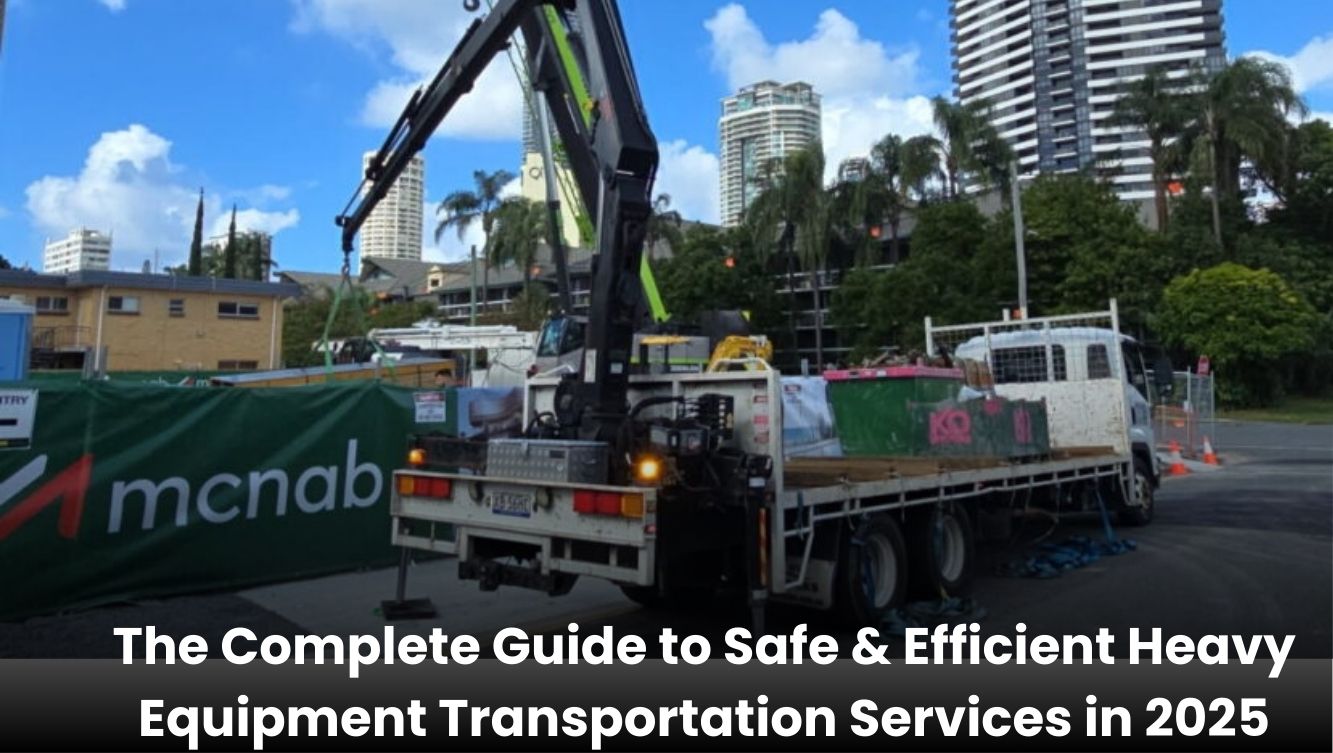The Complete Guide to Safe & Efficient Heavy Equipment Transportation Services in 2025
Modern construction sites rely on massive equipment: excavators, cranes, bulldozers, and mobile platforms that can’t be hauled on a whim. That’s where heavy equipment transportation services come into play. With tighter project timelines, higher payload volumes, and rising fuel costs, construction professionals now need smarter, faster, and safer ways to move machinery across diverse terrain.
Builders, contractors, logistics managers, and site engineers who don’t have time to sort through general recommendations are the target audience for this guide. This article is your guide for understanding how to move heavy machinery safely and effectively in 2025.
Why Heavy Equipment Transport Services Are Crucial in 2025
Australia’s construction industry is projected to grow by over 6% this year, with Brisbane and Ipswich seeing a surge in both residential and infrastructure projects. As this boom continues, the demand for heavy load movement is skyrocketing.
But here’s the catch: equipment is getting bigger, timelines are shrinking, and compliance is tightening.
Why it matters now more than ever:
- Construction timelines are tighter. Delays cost thousands.
- Machinery is more complex and heavier. You need precise transport, not just brute force.
- Urban expansion limits access. Streets in growing suburbs aren’t built for 80-ton machines.
- Local council regulations are strict. You need permits, escorts, and load planning done right.
Hiring a team that specializes in heavy equipment transportation services ensures that all these aspects are handled professionally, so your team stays focused on building, not hauling.
Key Challenges in Heavy Equipment Transportation
Transporting massive machinery isn’t as simple as loading and driving. Every move is a logistical puzzle that demands precision. Here are the biggest challenges professionals face:
- Road Permits & Route Planning
Oversized load transport in Queensland requires careful approval. Routes are planned based on weight, road width, overhead obstacles, and more. - Weight Restrictions & Load Limits
Bridges, local roads, and certain highways have strict axle-load limits. Ignoring these can lead to fines or damage to public infrastructure. - Site Access & Ground Conditions
Tight urban blocks? Unpaved roads? Steep inclines? Each site brings its own set of access hurdles. - Weather Dependencies
Rain and storms can delay transport and damage sensitive machinery. - Compliance Complexity
Regulatory paperwork, escort vehicle coordination, signage, and safety flags must all be managed accurately.
Professional heavy haulage solutions tackle all these with expertise, using experience and planning tools to make the impossible possible.
Safe Transport Practices & Compliance You Can’t Skip
Safety in 2025 isn’t just best practice—it’s mandatory. Governments, insurers, and developers are demanding proof of safety planning in every lift and move. Here’s what real professionals never compromise on:
- Certified Operators & Licensed Drivers
- Load Restraint Systems that exceed national standards
- Detailed Route Plans approved by councils
- GPS Tracking & Real-Time Updates
- Pilot Vehicles & Signage for Oversized Loads
- OH&S Compliance with Full Documentation
Whether it’s a 100-ton excavator or a modular building section, equipment transport safety is about eliminating unknowns.
Latest Technology Transforming Equipment Transport
Gone are the days of “guess and go.” Today’s transport fleets are fitted with intelligent tech that improves accuracy and safety:
- Telematics & Load Sensors
Track weight, balance, and axle pressure in real time. - Hydraulic Tilt Trailers
Ideal for loading machinery with low clearance. - Mobile Crane Hire Integration
Combine mobile cranes for complex load-outs and rooftop deliveries. - Route Optimization Software
Calculates the fastest, safest, and most cost-effective paths. - Automated Compliance Logs
Generate real-time reports for auditing and proof-of-compliance.
These aren’t just tech gimmicks—they’re tools that deliver faster turnarounds, safer transit, and better ROI on every job.
How to Choose the Right Transport Partner?
Every transport company will promise the same thing: safety, reliability, and speed. But how do you separate talk from true capability?
Look for these must-haves:
- Experience in heavy haulage solutions
- Fleet variety: prime movers, tilt trays, low loaders, escort vehicles
- In-house certified operators & drivers
- Transparent pricing with no hidden fees
- Insurance coverage for all cargo and public liability
Why local expertise matters: Providers familiar with Ipswich, Brisbane, and regional QLD know the roads, regulations, and weather conditions. They can often move loads that other companies turn down due to local restrictions.
FAQs:
- How is heavy equipment transport different from regular freight?
It involves oversized loads, permits, escorts, and specialized trailers. - How much does heavy equipment transport cost?
It depends on equipment size, distance, permits, and complexity of the move. - What are the various documents used for the transportation of goods?
A: Key documents include the bill of lading, invoice, packing list, delivery challan, e-way bill, and insurance papers. - How do you choose a reliable heavy equipment transport company?
Look for licensed, insured providers with experience, proper equipment, and customer reviews. - What is the role of a logistics provider in equipment transport?
They manage route planning, permits, vehicle coordination, and real-time tracking.
Conclusion:
Transporting heavy machinery involves more than just getting the machines from point A to point B; it also involves doing so safely, effectively, and without any problems. Selecting the best transport partner has never been more important in 2025, when construction schedules are more constrained and equipment is more specialised.
Every stage contributes to making sure your equipment gets on location, undamaged, and on schedule, from route planning and permit processing to loading accuracy and road safety. The best transport service safeguards your investment, your timetable, and your piece of mind in addition to moving equipment.


Comments are closed